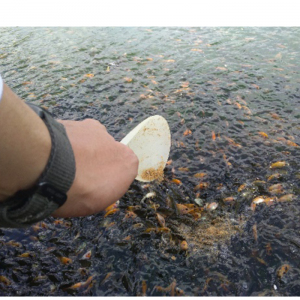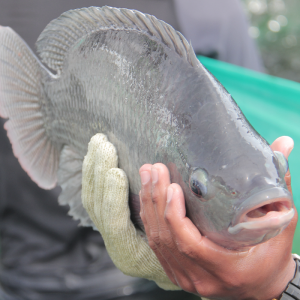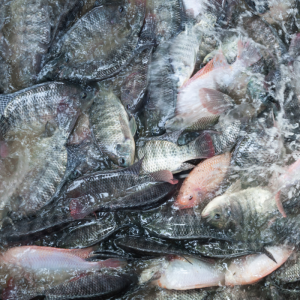
Genetics Key to TiLV Resistance
| Fri, 29 May 2020 - 15:28
A new study has found that resistance to Tilapia Lake Virus (TiLV) appears to be due to differences in genes between families of the same fish, reports Bonnie Waycott.
Hopes are high that these results will greatly improve the
protection of farmed tilapia stocks. Since its detection in Israel in 2014,
Tilapia Lake Virus (TiLV) has ravaged tilapia populations in 16 countries
across Asia, Africa and South America, and caused mortalities of up to 90%.
Arguably the biggest disease threat to tilapia farming and one of the biggest
for global aquaculture, several stages of the tilapia life cycle from
fingerlings to adults can be affected. Both wild and farmed fish are
susceptible, with clinical signs including behavioural changes, discolouration,
loss of scales, skin haemorrhages, open wounds, eyeball protrusion and
abdominal swelling. Fish can also be lethargic at the surface or be found
gasping.
There is currently no cure for viral diseases in aquaculture. Although vaccines and selective breeding have proved successful in reducing the severity of some, there are currently some knowledge gaps relating to TiLV with no effective or affordable vaccines available.
Now, a new study published in the journal Aquaculture has found that there is substantial genetic variation in the resistance of tilapia to the virus, with some families showing no mortalities to TiLV and others showing very high mortalities. The finding is offering hope that breeding programmes could be key to tackling one of the worst diseases to hit the global fish farming industry in recent years.
With funding from the UK government and through the framework of the CGIAR Research Program on Fish Agri-Food Systems, researchers from the University of Edinburgh's Roslin Institute and WorldFish analysed the genes of Genetically Improved Farmed Tilapia (GIFT), in an attempt to estimate the levels of genetic variation for resistance to TiLV.
"The Roslin Institute has been working in partnership with WorldFish to improve selective breeding for Nile tilapia, " said Professor Ross Houston, lead author of the study and personal chair of aquaculture genetics at the Roslin Institute.
"This has included developing genomic tools and looking at new target traits for genetic improvement. One of these traits is disease resistance. In this case, we took advantage of an outbreak in a tilapia pond where many different families of tilapia were affected. Using the data from survivors and mortalities from this outbreak, and how this varies across families, we were able to show that resistance to TiLV is highly heritable."
Using data from 1821 pedigreed fish from 124 different families of tilapia collected during and after the pond outbreak, Houston and his team defined resistance using binary survival and days-to-death traits. They were able to record mortality levels because the fish contained electronic tags, which were used to assign individuals to specific families. Using the pedigree for the fish affected by the outbreak, it was also possible to separate how much of the variation in mortality was due to genetics, and how much was due to other reasons such as environmental factors.
TiLV resistance highly heritable
The results showed that resistance to TiLV was highly heritable, with about 50-60% of the variation in mortality due to genetics (this is particularly high for a disease resistance trait). Some families of tilapia had zero mortality while others had a 100% death rate, meaning that selective breeding for improved resistance is likely to be highly effective. The team was also able to show that selecting for improved resistance to TiLV is unlikely to have any impact on the growth of the fish and may also benefit farmers' yields. The study also stated that using data from a natural pond outbreak, as opposed to a controlled experiment, better reflected the method of infection in terms of time of exposure and spread within the population.
The selective breeding of fish with genes that are resistant to TiLV is said to be one way of limiting the damage of this disease, but there are some technical and legislative barriers to overcome, according to Ross Houston.
"The technical barriers are related to the fact that a reliable and repeatable TiLV experimental challenge model would be required to maximise the potential for breeding for TiLV resistance," he said.
"There is a lot of research on developing such challenge models and with some promising results to date, so this is likely to be overcome soon. This would avoid having to rely on pond outbreak data to use for breeding, where it is difficult to predict where and when outbreaks will occur."
Genomic tools could also be extremely useful to identify genetic markers that could be used to predict TiLV resistance breeding values, even in the absence of disease challenge data on close relatives, he added.
Key farmed species
Nile tilapia are among the key species farmed worldwide today. According to FAO data, the production of tilapia reached around 6.2 million tonnes in 2016. The species is also one of the major sources of animal protein, particularly in developing countries in Asia, South America and Africa and can be farmed under a variety of systems from extensive backyard ponds to large, commercial operations, with little environmental impact. It's also an affordable source of food for many people and a healthy source of nutrients and essential fatty acids.
Factors such as these make it all the more important for tilapia producers to consider a host of options to increase the chances of avoiding TiLV. In addition to considering disease resistance and using specific pathogen-free tilapia stocks for breeding programmes, investing in advanced molecular diagnostics will enable farmers to determine whether individuals are virus-free at different stages of the tilapia life cycle. Other key preventive steps include screening live tilapia entering a country as seed or broodstock for aquaculture purposes, contingency plans for possible outbreaks and regular biosecurity audits and disease surveillance programmes.
"Improvements in biosecurity are always important and this can be related to transparency and communication," said Ross Houston.
"There is other research that is targeting the development of vaccines, which would also be very useful, but in addition to cost issues they are very difficult to administer to young tilapia which can be badly affected by TiLV. In this sense, genetics and breeding are definitely major opportunities here."
Together with WorldFish, the Roslin Institute is part of an ambitious and active research programme where genomic tools are being developed to find genes and markers linked to disease resistance. Hopes are high that the study by both organisations could lead to new opportunities to improve breeding for disease resistance. Further research will also be required to evaluate the genetic architecture of host resistance to TiLV and evaluate the possibility of marker-assisted or genomic selection to expedite the breeding of tilapia strains with improved resistance to the virus, according to the study.
"It would be very interesting to find out the reasons underlying why some families are seemingly fully resistant, and others fully susceptible in our study," Ross Houston commented. "This is both scientifically important and also has potential applications to provide new solutions to tackle the disease."
Source: World Fishing






















